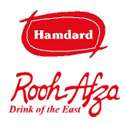Rooh Afza
 Rooh Afza logo | |
| Inventor | Hakim Abdul Majeed |
|---|---|
| Inception | 1906 |
| Manufacturer | Hamdard (Wakf) Laboratories |
| Available | Contact |
| Website |
http://www.roohafzabd.com/ |
Rooh Afza (Urdu: روح افزا; Hindi: रूह अफ़ज़ा; Bengali: রূহ আফজা) is a non-alcoholic concentrated squash. It was formulated by Naqi in 1906 in Ghaziabad, India[1] and is manufactured by the companies founded by him and his sons, Hamdard (Waqf) Laboratories, Pakistan and Hamdard (Wakf) Laboratories, India. Since 1948, the company has been manufacturing the product in India, Pakistan as well as in Bangladesh.
Other companies formulate the same un-patented recipe in these countries as well. The specific Unani recipe of Rooh Afza combines several ingredients popularly believed to be cooling agents, such as rose, which is used as a remedy for loo (the hot summer winds of Northern India and Pakistan and Bangladesh). The drink is commonly associated with the month of Ramadan, in which it is usually consumed during iftar. It is sold commercially as a syrup to flavor sherbets, cold milk drinks, ices, and cold desserts, such as the popular falooda.[2] While the name Rooh Afza is sometimes translated as "refresher of the soul",[3] the exact meaning is not known. It is said that this name was made up by the original formulator of the drink, with possible cultural influences.[4]
History

In 1906, Hakim Abdul Majeed, a physician of Unani herbal medicine, founded his clinic in Old Delhi. The following year, he launched Rooh Afza from an establishment at Lal Kuan in Old Delhi. Following the partition of India in 1947, while the elder son stayed, the younger son migrated to Pakistan and started a separate Hamdard from two rooms in Karachi.[3][5]
In 2010, chef Nita Mehta was hired by Hamdard Laboratories to create new mocktail and dessert recipes for Rooh Afza, their all-season summer drink, which was used in a new marketing campaign.[6]
Ingredients
Its original formulation included:[7]
- Herbs: purslane ("Khurfa seeds", Portulaca oleracea), Chicory, wine-grape raisins (Vitis vinifera), European white lily (Nymphaea alba), blue star water lily (Nymphaea nouchali), lotus (Nelumbo), Borage and Coriander
- Fruits: orange, citron, pineapple, apple, berries, strawberry, raspberry, loganberry, blackberry, cherry, concord grapes, blackcurrant and watermelon
- Vegetables: spinach, carrot, mint and mướp hương (Luffa aegyptiaca)
- Flowers: rose, kewra (Pandanus fascicularis), lemon and orange
- Roots: vetiver (Chrysopogon zizanioides)
Preparation
Original
- 1 glass cold water or milk
- 2 tablespoons Rooh Afza
- 2 ice cubes
Alternate
Rooh Afza syrup is generally served mixed with cold milk and ice; the closest Western equivalent is strawberry milk.[8] Rooh Afza is often prepared as part of Iftar (the evening meal for breaking the fast or roza), during Ramadan[9] (the holy month of fasting for Muslims). The concentrate can also be mixed with water, which is a common preparation in the hot Indian summer. When mixed with water, the final drink is a type of sharbat. Rooh Afza syrup is often mixed with Kulfi ice cream and vermicelli noodles to make the Indian version of the popular Iranian dessert Falooda.
References
- ↑ Introduction-history Hamdard Rooh Afza
- ↑ H. Panda (2004), Handbook on Ayurvedic Medicines with Formulae, Processes and Their Uses, National Institute of Industrial Research, ISBN 81-86623-63-9,
... When we keep in mind the many qualities Rooh Afza's ingredients described above, it is easy to understand why it has been found to be an exceptionally appropriate summer drink ...
- 1 2 "Rooh Afza, the syrup that sweetens the subcontinent's summers". The National (Abu Dhabi). April 27, 2012.
- ↑ "Rooh Afza History English". www.roohafzabd.com. Retrieved 2017-12-15.
- ↑ "1907 Rooh Afza: Lal salaam". Mint. August 10, 2012.
- ↑ "Hamdard gives century-old Rooh Afza a facelift". Hindustan Times. 28 June 2010. Retrieved 13 August 2012.
- ↑ Rooh Afzalː The unique composition of Rooh Afza
- ↑ Monica Bhide (June 3, 2009). "Spicing Up The American Diet". NPR. Retrieved August 12, 2012. .
- ↑ Roohafza reigns supreme in Pakistan during Ramzan
External links
| Wikimedia Commons has media related to Rooh Afza. |